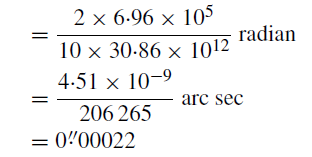


 الفيزياء الكلاسيكية
الفيزياء الكلاسيكية
 الكهربائية والمغناطيسية
الكهربائية والمغناطيسية
 علم البصريات
علم البصريات
 الفيزياء الحديثة
الفيزياء الحديثة
 النظرية النسبية
النظرية النسبية
 الفيزياء النووية
الفيزياء النووية
 فيزياء الحالة الصلبة
فيزياء الحالة الصلبة
 الليزر
الليزر
 علم الفلك
علم الفلك
 المجموعة الشمسية
المجموعة الشمسية
 الطاقة البديلة
الطاقة البديلة
 الفيزياء والعلوم الأخرى
الفيزياء والعلوم الأخرى
 مواضيع عامة في الفيزياء
مواضيع عامة في الفيزياء|
Read More
Date: 26-5-2016
Date: 6-2-2017
Date: 19-8-2020
|
Stellar parallax:ExtHelveticaar planets
Of accelerating interest is the possible detection of minute cyclical positional shifts in a star’s position caused by the presence of planets in orbit about it. The detection of extHelveticaar planetary systems is of great importance but it offers extreme technical challenges requiring regular measurements of very small changes of a star’s coordinates relative to other local field stars.
A feel for the problem can be appreciated by considering our own solar system as providing an example. Jupiter is the most massive planet orbiting the Sun. The centre of mass based on this twobody system is approximately at 1 solar radius (696 000 km) from the centre of the Sun. As seen from a large distance, say at some star, the Sun would appear to move by its diameter over an interval of time of one-half the orbital period of Jupiter. If the observer were at 10 parsecs (relatively close for a star), the apparent displacement over this time interval would be

an extremely small angle.
Recent observations using other principles suggest that some stellar systems do indeed have planets of the order of the same size as Jupiter but orbiting much closer to the parent body with periods of revolution of a few days. With such shorter timescales, the necessary measurements would accrue more easily but unfortunately the amount of motion of the star about the centre of gravity of the system also reduces. As techniques improve in sensitivity, no doubt extHelveticaar planets will eventually be detected and monitored by refined positional measurements.



|
|
|
|
دخلت غرفة فنسيت ماذا تريد من داخلها.. خبير يفسر الحالة
|
|
|
|
|
|
|
ثورة طبية.. ابتكار أصغر جهاز لتنظيم ضربات القلب في العالم
|
|
|
|
|
|
|
قسم شؤون المعارف ووفد من جامعة البصرة يبحثان سبل تعزيز التعاون المشترك
|
|
|